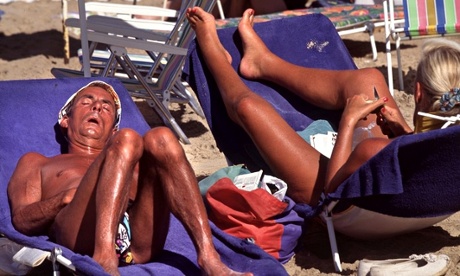
Now that summer is upon us here in the northern hemisphere, it’s getting more common to see articles, diets, exercise regimes and the like that tell you how to achieve the perfect beach body, or some variation thereof. For many people (but particularly women) there is increasing pressure to achieve a body type that is acceptable for displaying on the beach. Why bodily display is considered important is a whole other discussion, but countless people clearly believe that it is.
Even when you’re actually on the beach, there is still no excuse for not maintaining your body’s top condition. On my last holiday, I witnessed a beach exercise class for women taking place. It was a yoga class specifically. I remember this vividly because the instructor was the formidable sort who ended the session by screaming “relax from your yoga!” in a terrifying Russian accent, which seemed to misunderstand the whole point of both yoga. And relaxing, as far as I know.
But if people are so keen to obtain a “perfect beach body”, then it is important to establish what qualities a perfect beach body would have. There are many things that are mentioned in such contexts, like the bikini bridge or thigh gap or sternum ski-lift or some other guff. But these things are pure social constructs (especially the last one, which I made up). So what science say you need to achieve the perfect beach body? Well, there are several requirements.
Measurements
Obviously this will vary from person to person, what with humans having such a drastic variety in dimensions, but the perfect beach body presented in the typical upright posture starts at the scalp (hair has too much individual variation and has no nervous innervation anyway so is not considered here) and ends at the sole of the feet. Or, if you’re going from the ground up, the other way around.
The waistline also varies between individuals, but for a perfect beach body it must form a complete perimeter around the mid-point of the body. Regardless of size, this is essential. But don’t panic, as it should be logically impossible for the waistline to not go all the way around the body, assuming it’s in one piece.
Foot size is also an important measurement. The perfect beach body would have feet long and wide enough to allow effective locomotion on sand. Walking on sand requires 2 to 3 times as much energy as walking on hard surfaces owing to different physical properties of the substances, so the perfect beach body would have feet capable of sustaining this activity.
Anatomy
The perfect beach body requires the full complement of essential organs in order to sustain functioning. As well as these, the perfect body should have a functioning musculoskeletal system, along with a working nervous system, to allow autonomous movement, which will help in getting to and from the beach, especially as beaches can often be in remote, hard to access coastal areas. But even if the beach is in an easily-accessed location with abundant transport links, you usually still need a functioning musculoskeletal system to use these.
Given that beach-based activity can be physically strenuous (as discussed above) then a working digestive system is necessary to convert food and drink sources into energy. Given that people typically visit the beach in hot, sunny conditions, it’s important to be aware of the physical consequences of these, and the perfect beach body would be able to cope with the stresses of such an environment.
Given that beaches are by the sea, it could be argued that the “perfect” beach body would be better equipped to handle aquatic conditions. Perhaps the ideal beach body would have gills for survival in the water, like Kevin Costner in Waterworld. However, humans place a great deal of importance on physical attractiveness when at the beach, and someone who has gills, a totally unfamiliar physical feature for humans, would likely cause upset and be socially rejected by people who observe them, like Kevin Costner in Waterworld.
So while it might be advantageous in the physical sense for a perfect beach body to have aquatic adaptations, the idea of some sort of “marine primate” is clearly ludicrous.
Skincare
Given that conditions at the beach typically involve exposure of the skin to direct sunlight, it is extra important to ensure that your skin is capable of handling this. The perfect beach body has skin that goes all around and covers are last part of it, in order to keep all the vulnerable and important bits on the inside. Some people may have parts of their body that aren’t covered by skin, but this is usually a temporary situation, ending with repair or, if ignored for too long, death. The skin should also include mechanisms to address or cope with direct exposure to UV rays.
It is important to note that even the most perfect beach body can require extra assistance with avoiding sun damage, via things like sun block. However, no body known to science has ever been capable of deriving protection from ridiculous magic water.
The perfect beach body’s skin should also have sufficient sweat glands to help regulate temperature, and also have pores small enough to make sure that sand grains stay on the outside.
So, should your body have all the qualities listed above, congratulations! You’ve got the perfect beach body. Anything else is just personal preference. And if you, through no fault of your own, don’t have a body that conforms to the above description, then again don’t worry. As you should have spotted by now, the very concept of a “perfect beach body” is a meaningless one.
Dean Burnett will follow this up in November with a scientific guide to how to get the perfect winter body (it’s exactly the same as the one described here, but with a coat on). You can avoid his less-than-ideal body altogether by following him on Twitter, @garwboy

